Chapter 15: Psychosocial Development in Early Childhood
Chapter 15 Learning Objectives
- Describe Erikson’s third stage of initiative vs. guilt
- Describe the changes in self-concept and self-esteem
- Describe children’s understanding of others
- Describe emotional regulation and delayed gratification
- Describe young children’s understanding of morality
- Summarize the main theories of gender development
- Explain the terms transgender, gender dysphoria, and intersex
- Describe the major parenting styles and their consequences for children
- Describe the role of siblings in children’s development
- Summarize the types of play in which children engage
- Describe the influence of the media on young children’s social development
Erikson: Initiative vs. Guilt
The trust and autonomy of previous stages develop into a desire to take initiative or to think of ideas and initiative action (Erikson, 1982). Children may want to build a fort with the cushions from the living room couch or open a lemonade stand in the driveway or make a zoo with their stuffed animals and issue tickets to those who want to come. Or they may just want to get themselves ready for bed without any assistance. To reinforce taking initiative, caregivers should offer praise for the child’s efforts and avoid being critical of messes or mistakes. Placing pictures of drawings on the refrigerator, purchasing mud pies for dinner, and admiring towers of legos will facilitate the child’s sense of initiative.
Self-Concept and Self-Esteem
Early childhood is a time of forming an initial sense of self. Self-concept is our self-description according to various categories, such as our external and internal qualities. In contrast, self- esteem is an evaluative judgment about who we are. The emergence of cognitive skills in this age group results in improved perceptions of the self. If asked to describe yourself to others you would likely provide some physical descriptors, group affiliation, personality traits, behavioral quirks, values, and beliefs. When researchers ask young children the same open-ended question, the children provide physical descriptors, preferred activities, and favorite possessions. Thus, a three-year-old might describe herself as a three years-old girl with red hair, who likes to play with legos. This focus on external qualities is referred to as the categorical self.
However, even children as young as three know there is more to themselves than these external characteristics. Harter and Pike (1984) challenged the method of measuring personality with an open-ended question as they felt that language limitations were hindering the ability of young children to express their self-knowledge. They suggested a change to the method of measuring self-concept in young children, whereby researchers provide statements that ask whether something is true of the child (e.g., “I like to boss people around”, “I am grumpy most of the time”). Consistent with Harter and Pike’s suspicions, those in early childhood answer these statements in an internally consistent manner, especially after the age of four (Goodvin, Meyer, Thompson & Hayes, 2008) and often give similar responses to what others (parents and teachers) say about the child (Brown, Mangelsdorf, Agathen, & Ho, 2008; Colwell & Lindsey, 2003).
Young children tend to have a generally positive self- image. This optimism is often the result of a lack of social comparison when making self-evaluations (Ruble, Boggiano, Feldman, & Loeble, 1980), and with comparison between what the child once could do to what they can do now (Kemple, 1995).
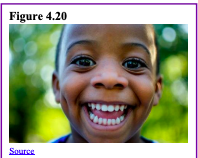
However, this does not mean that preschool children are exempt from negative self-evaluations. Preschool children with insecure attachments to their caregivers tend to have lower self-esteem at age four (Goodvin et al., 2008). Maternal negative affect was also found by Goodwin and her colleagues to produce more negative self-evaluations in preschool children.
Self-Control
Self-control is not a single phenomenon but is multi-facetted. It includes response initiation, the ability to not initiate a behavior before you have evaluated all the information, response inhibition, the ability to stop a behavior that has already begun, and delayed gratification, the ability to hold out for a larger reward by forgoing a smaller immediate reward (Dougherty, Marsh, Mathias, & Swann, 2005). It is in early childhood that we see the start of self-control, a process that takes many years to fully develop. In the now classic “Marshmallow Test” (Mischel, Ebbesen, & Zeiss, 1972) children are confronted with the choice of a small immediate reward (a marshmallow) and a larger delayed reward (more marshmallows). Walter Mischel and his colleagues over the years have found that the ability to delay gratification at the age of four predicted better academic performance and health later in life (Mischel, et al., 2011). Self- control is related to executive function, discussed earlier in the chapter. As executive function improves, children become less impulsive (Traverso, Viterbori, & Usai, 2015).
Gender
Another important dimension of the self is the sense of self as male or female. Preschool aged children become increasingly interested in finding out the differences between boys and girls, both physically and in terms of what activities are acceptable for each. While two-year-olds can identify some differences and learn whether they are boys or girls, preschoolers become more interested in what it means to be male or female. Gender is the cultural, social and psychological meanings associated with masculinity and feminity (Spears Brown & Jewell, 2018). A person’s sense of self as a member of a particular gender is known as gender identity. The development of gender identity appears to be due to an interaction among biological, social and representational influences (Ruble, Martin, & Berenbaum, 2006). Gender roles, or the expectations associated with being male or female, are learned in one’s culture throughout childhood and into adulthood.
Gender socialization focuses on what young children learn about gender from society, including parents, peers, media, religious institutions, schools, and public policies. Children learn about what is acceptable for females and males early, and in fact, this socialization may even begin the moment a parent learns that a child is on the way. Knowing the sex of the child can conjure up images of the child’s behavior, appearance, and potential on the part of a parent, and this stereotyping continues to guide perception through life. Consider parents of newborns, shown a 7-pound, 20-inch baby, wrapped in blue (a color designating males) describe the child as tough, strong, and angry when crying. Shown the same infant in pink (a color used in the United States for baby girls), these parents are likely to describe the baby as pretty, delicate, and frustrated when crying (Maccoby & Jacklin, 1987). Female infants are held more, talked to more frequently and given direct eye contact, while male infant interactions are often mediated through a toy or activity.

As they age, sons are given tasks that take them outside the house and that have to be performed only on occasion, while girls are more likely to be given chores inside the home, such as cleaning or cooking that are performed daily. Sons are encouraged to think for themselves when they encounter problems and daughters are more likely to be given assistance, even when they are working on an answer. Parents also talk to their children differently according to their gender. For example, parents talk to sons more in detail about science, and they discuss numbers and counting twice as often than with daughters (Chang, Sandhofer, & Brown, 2011). How are these beliefs about behaviors and expectations based on gender transmitted to children?
Theories of Gender Development
One theory of gender development in children is social learning theory, which argues that behavior is learned through observation, modeling, reinforcement, and punishment (Bandura, 1997). Children are rewarded and reinforced for behaving in concordance with gender roles that have been presented to them since birth and punished for breaking gender roles. In addition, social learning theory states that children learn many of their gender roles by modeling the behavior of adults and older children and, in doing so, develop ideas about what behaviors are appropriate for each gender. Cognitive social learning theory also emphasizes reinforcement, punishment, and imitation, but adds cognitive processes. These processes include attention, self- regulation, and self-efficacy. Once children learn the significance of gender, they regulate their own behavior based on internalized gender norms (Bussey & Bandura, 1999).
Another theory is that children develop their own conceptions of the attributes associated with maleness or femaleness, which is referred to as gender schema theory (Bem, 1981). Once children have identified with a particular gender, they seek out information about gender traits, behaviors, and roles. This theory is more constructivist as children are actively acquiring their gender. For example, friends discuss what is acceptable for boys and girls, and popularity may be based on what is considered ideal behavior for their gender.
Developmental intergroup theory states that many of our gender stereotypes are so strong because we emphasize gender so much in culture (Bigler & Liben, 2007). Developmental intergroup theory postulates that adults’ heavy focus on gender leads children to pay attention to gender as a key source of information about themselves and others, to seek out any possible gender differences, and to form rigid stereotypes based on gender that are subsequently difficult to change.
Transgender Children
Many young children do not conform to the gender roles modeled by the culture and even push back against assigned roles. However, a small percentage of children actively reject the toys, clothing, and anatomy of their assigned sex and state they prefer the toys, clothing and anatomy of the opposite sex. Approximately 0.3 percent of the United States population identify as transgender or identifying with the gender opposite their natal sex (Olson & Gülgöz, 2018).
Transgender adults have stated that they identified with the opposite gender as soon as they began talking (Russo, 2016). Some of these children may experience gender dysphoria, or distress accompanying a mismatch between one’s gender identity and biological sex (APA, 2013), while other children do not experience discomfort regarding their gender identity.
Current research is now looking at those young children who identify as transgender and have socially transitioned. In 2013, a longitudinal study following 300 socially transitioned transgender children between the ages of 3 and 12 began (Olson & Gülgöz, 2018). Socially transitioned transgender children identify with the gender opposite than the one assigned at birth, and they change their appearance and pronouns to reflect their gender identity. Findings from the study indicated that the gender development of these socially transitioned children looked similar to the gender development of cisgender children, or those whose gender and sex assignment at birth matched. These socially transitioned transgender children exhibited similar gender preferences and gender identities as their gender matched peers. Further, these children who were living everyday according to their gender identity and were supported by their families, exhibited positive mental health.
Some individuals who identify as transgender are intersex; that is born with either an absence or some combination of male and female reproductive organs, sex hormones, or sex chromosomes (Jarne & Auld, 2006). In humans, intersex individuals make up more than 150 million people, or about two percent of the world’s population (Blackless et al., 2000). There are dozens of intersex conditions, and intersex individuals demonstrate the diverse variations of biological sex. Some examples of intersex conditions include:
- Turner syndrome or the absence of, or an imperfect, second X chromosome
- Congenital adrenal hyperplasia or a genetic disorder caused by an increased production of androgens
- Androgen insensitivity syndrome or when a person has one X and one Y chromosome, but is resistant to the male hormones or androgens
Greater attention to the rights of children born intersex is occurring in the medical field, and intersex children and their parents should work closely with specialists to ensure these children develop positive gender identities.
How much does gender matter for children: Starting at birth, children learn the social meanings of gender from adults and their culture. Gender roles and expectations are especially portrayed in children’s toys, books, commercials, video games, movies, television shows and music (Khorr, 2017). Therefore, when children make choices regarding their gender identification, expression, and behavior that may be contrary to gender stereotypes, it is important that they feel supported by the caring adults in their lives. This support allows children to feel valued, resilient, and develop a secure sense of self (American Academy of Pediatricians, 2015).
Parenting Styles
Relationships between parents and children continue to play a significant role in children’s development during early childhood. As children mature, parent-child relationships naturally change. Preschool and grade-school children are more capable, have their own preferences, and sometimes refuse or seek to compromise with parental expectations. This can lead to greater parent-child conflict, and how conflict is managed by parents further shapes the quality of parent-child relationships.
Baumrind (1971) identified a model of parenting that focuses on the level of control/ expectations that parents have regarding their children and how warm/responsive they are. This model resulted in four parenting styles. In general, children develop greater competence and self-confidence when parents have high, but reasonable expectations for children’s behavior, communicate well with them, are warm, loving and responsive, and use reasoning, rather than coercion as preferred responses to children’s misbehavior. This kind of parenting style has been described as authoritative (Baumrind, 2013). Authoritative parents are supportive and show interest in their kids’ activities but are not overbearing and allow them to make constructive mistakes. Parents allow negotiation where appropriate, and consequently this type of parenting is considered more democratic.

Authoritarian is the traditional model of parenting in which parents make the rules and children are expected to be obedient. Baumrind suggests that authoritarian parents tend to place maturity demands on their children that are unreasonably high and tend to be aloof and distant. Consequently, children reared in this way may fear rather than respect their parents and, because their parents do not allow discussion, may take out their frustrations on safer targets- perhaps as bullies toward peers.
Permissive parenting involves holding expectations of children that are below what could be reasonably expected from them. Children are allowed to make their own rules and determine their own activities. Parents are warm and communicative but provide little structure for their children. Children fail to learn self-discipline and may feel somewhat insecure because they do not know the limits.
Uninvolved parents are disengaged from their children. They do not make demands on their children and are non-responsive. These children can suffer in school and in their relationships with their peers (Gecas & Self, 1991).
Keep in mind that most parents do not follow any model completely. Real people tend to fall somewhere in between these styles. Sometimes parenting styles change from one child to the next or in times when the parent has more or less time and energy for parenting. Parenting styles can also be affected by concerns the parent has in other areas of his or her life. For example, parenting styles tend to become more authoritarian when parents are tired and perhaps more authoritative when they are more energetic. Sometimes parents seem to change their parenting approach when others are around, maybe because they become more self-conscious as parents or are concerned with giving others the impression that they are a “tough” parent or an “easy- going” parent. Additionally, parenting styles may reflect the type of parenting someone saw modeled while growing up. See Table 4.3 for Baumrind’s parenting style descriptions.
Table 4.3 Comparison of Four Parenting Styles
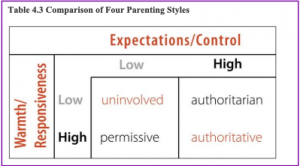
Culture: The impact of culture and class cannot be ignored when examining parenting styles. The model of parenting described above assumes that the authoritative style is the best because this style is designed to help the parent raise a child who is independent, self-reliant and responsible. These are qualities favored in “individualistic” cultures such as the United States, particularly by the middle class. However, in “collectivistic” cultures such as China or Korea, being obedient and compliant are favored behaviors. Authoritarian parenting has been used historically and reflects cultural need for children to do as they are told. African-American, Hispanic and Asian parents tend to be more authoritarian than non-Hispanic whites. In societies where family members’ cooperation is necessary for survival, rearing children who are independent and who strive to be on their own makes no sense. However, in an economy based on being mobile in order to find jobs and where one’s earnings are based on education, raising a child to be independent is very important.
In a classic study on social class and parenting styles, Kohn (1977) explains that parents tend to emphasize qualities that are needed for their own survival when parenting their children.
Working class parents are rewarded for being obedient, reliable, and honest in their jobs. They are not paid to be independent or to question the management; rather, they move up and are considered good employees if they show up on time, do their work as they are told, and can be counted on by their employers. Consequently, these parents reward honesty and obedience in their children. Middle class parents who work as professionals are rewarded for taking initiative, being self-directed, and assertive in their jobs. They are required to get the job done without being told exactly what to do. They are asked to be innovative and to work independently. These parents encourage their children to have those qualities as well by rewarding independence and self-reliance. Parenting styles can reflect many elements of culture.
Spanking
Spanking is often thought of as a rite of passage for children, and this method of discipline continues to be endorsed by the majority of parents (Smith, 2012). Just how effective is spanking, however, and are there any negative consequences? After reviewing the research, Smith (2012) states “many studies have shown that physical punishment, including spanking, hitting and other means of causing pain, can lead to increased aggression, antisocial behavior, physical injury and mental health problems for children” (p. 60). Gershoff, (2008) reviewed decades of research and recommended that parents and caregivers make every effort to avoid physical punishment and called for the banning of physical discipline in all U.S. schools.
In a longitudinal study that followed more than 1500 families from 20 U.S. cities, parents’ reports of spanking were assessed at ages three and five (MacKenzie, Nicklas, Waldfogel, & Brooks-Gunn, 2013). Measures of externalizing behavior and receptive vocabulary were assessed at age nine. Results indicated that those children who were spanked at least twice a week by their mothers scored 2.66 points higher on a measure of aggression and rule-breaking than those who were never spanked. Additionally, those who were spanked less, still scored 1.17 points higher than those never spanked. When fathers did the spanking, those spanked at least two times per week scored 5.7 points lower on a vocabulary test than those never spanked. This study revealed the negative cognitive effects of spanking in addition to the increase in aggressive behavior.
Internationally, physical discipline is increasingly being viewed as a violation of children’s human rights. According to Save the Children (2019), 46 countries have banned the use of physical punishment, and the United Nations Committee on the Rights of the Child (2014) called physical punishment “legalized violence against children” and advocated that physical punishment be eliminated in all settings.
Many alternatives to spanking are advocated by child development specialists and include:
- Praising and modeling appropriate behavior
- Providing time-outs for inappropriate behavior
- Giving choices
- Helping the child identify emotions and learning to calm down
- Ignoring small annoyances
- Withdrawing privileges
Sibling Relationships
Siblings spend a considerable amount of time with each other and offer a unique relationship that is not found with same-age peers or with adults. Siblings play an important role in the development of social skills.
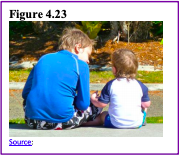
Cooperative and pretend play interactions between younger and older siblings can teach empathy, sharing, and cooperation (Pike, Coldwell, & Dunn, 2005), as well as, negotiation and conflict resolution (Abuhatoum & Howe, 2013). However, the quality of sibling relationships is often mediated by the quality of the parent-child relationship and the psychological adjustment of the child (Pike et al., 2005). For instance, more negative interactions between siblings have been reported in families where parents had poor patterns of communication with their children (Brody, Stoneman, & McCoy, 1994).
Children who have emotional and behavioral problems are also more likely to have negative interactions with their siblings. However, the psychological adjustment of the child can sometimes be a reflection of the parent-child relationship. Thus, when examining the quality of sibling interactions, it is often difficult to tease out the separate effect of adjustment from the effect of the parent-child relationship.
While parents want positive interactions between their children, conflicts are going to arise, and some confrontations can be the impetus for growth in children’s social and cognitive skills. The sources of conflict between siblings often depend on their respective ages. Dunn and Munn (1987) revealed that over half of all sibling conflicts in early childhood were disputes about property rights. By middle childhood this starts shifting toward control over social situation, such as what games to play, disagreements about facts or opinions, or rude behavior (Howe, Rinaldi, Jennings, & Petrakos, 2002). Researchers have also found that the strategies children use to deal with conflict change with age, but this is also tempered by the nature of the conflict. Abuhatoum and Howe (2013) found that coercive strategies (e.g., threats) were preferred when the dispute centered on property rights, while reasoning was more likely to be used by older siblings and in disputes regarding control over the social situation. However, younger siblings also use reasoning, frequently bringing up the concern of legitimacy (e.g., “You’re not the boss”) when in conflict with an older sibling. This is a very common strategy used by younger siblings and is possibly an adaptive strategy in order for younger siblings to assert their autonomy (Abuhatoum & Howe, 2013). A number of researchers have found that children who can use non-coercive strategies are more likely to have a successful resolution, whereby a compromise is reached and neither child feels slighted (Ram & Ross, 2008; Abuhatoum & Howe, 2013). Not surprisingly, friendly relationships with siblings often lead to more positive interactions with peers. The reverse is also true. A child can also learn to get along with a sibling, with, as the song says, “a little help from my friends” (Kramer & Gottman, 1992).
Play
Freud saw play as a means for children to release pent-up emotions and to deal with emotionally distressing situations in a more secure environment. Vygotsky and Piaget saw play as a way of children developing their intellectual abilities (Dyer & Moneta, 2006). All three theorists saw play as providing positive outcomes for children. Parten (1932) observed two to five-year-old children and noted six types of play: Three labeled as non-social play (unoccupied, solitary, and onlooker) and three categorized as social play (parallel, associative, and cooperative). Table 4.4 describes each type of play.
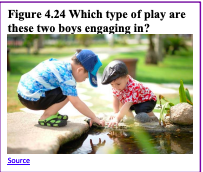
Younger children engage in non-social play more than those older; by age five associative and cooperative play are the most common forms of play (Dyer & Moneta, 2006).
Table 4.4 Parten’s Classification of Types of Play in Preschool Children
|
Category |
Description |
|
Unoccupied Play |
Children’s behavior seems more random and without a specific goal. This is the least common form of play. |
|
Solitary Play |
Children play by themselves, do not interact with others, nor are they engaging in similar activities as the children around them. |
|
Onlooker Play |
Children are observing other children playing. They may comment on the activities and even make suggestions but will not directly join the play. |
|
Parallel Play |
Children play alongside each other, using similar toys, but do not directly act with each other. |
|
Associative Play |
Children will interact with each other and share toys but are not working toward a common goal. |
|
Cooperative Play |
Children are interacting to achieve a common goal. Children may take on different tasks to reach that goal. |
An intriguing occurrence in early childhood is the emergence of imaginary companions.
Researchers differ in how they define what qualifies as an imaginary companion. Some studies include only invisible characters that the child refers to in conversation or plays with for an extended period of time. Other researchers also include objects that the child personifies, such as a stuffed toy or doll, or characters the child impersonates every day. Estimates of the number of children who have imaginary companions varies greatly (from as little as 6% to as high as 65%) depending on what is included in the definition (Gleason, Sebanc, & Hartup, 2000).
Little is known about why children create imaginary companions, and more than half of all companions have no obvious trigger in the child’s life (Masih, 1978). Imaginary companions are sometimes based on real people, characters from stories, or simply names the child has heard (Gleason, et. al., 2000). Imaginary companions often change over time. In their study, Gleason et al. (2000) found that 40% of the imaginary companions of the children they studied changed, such as developing superpowers, switching age, gender, or even dying, and 68% of the characteristics of the companion were acquired over time. This could reflect greater complexity in the child’s “creation” over time and/or a greater willingness to talk about their imaginary playmates.
In addition, research suggests that contrary to the assumption that children with imaginary companions are compensating for poor social skills, several studies have found that these children are very sociable (Mauro, 1991; Singer & Singer, 1990; Gleason, 2002). However, studies have reported that children with imaginary companions are more likely to be first-borns or only-children (Masih, 1978; Gleason et al., 2000, Gleason, 2002). Although not all research has found a link between birth order and the incidence of imaginary playmates (Manosevitz, Prentice, & Wilson, 1973). Moreover, some studies have found little or no difference in the presence of imaginary companions and parental divorce (Gleason et al., 2000), number of people in the home, or the amount of time children are spending with real playmates (Masih, 1978; Gleason & Hohmann, 2006).
Do children treat real friends differently? The answer appears to be not really. Young children view their relationship with their imaginary companion to be as supportive and nurturing as with their real friends. Gleason has suggested that this might suggest that children form a schema of what is a friend and use this same schema in their interactions with both types of friends (Gleason, et al., 2000; Gleason, 2002; Gleason & Hohmann, 2006).
Children and the Media
Children view far more television today than in the 1960s; so much that they have been referred to as Generation M for Media. Almost all American families have at least one TV set, and half own three or more (Nielsen Company, 2009). For children age six and under, two-thirds watch television every day, usually for two hours (Rideout & Hamel, 2006). Even when involved in other activities, such as playing, there is often a television on nearby (Christakis, 2009; Kirkorian, Pempek, & Murphy, 2009). Research has consistently shown that too much television adversely affects children’s behavior, health, and achievement (Gentile & Walsh, 2002; Robinson, Wilde, & Navracruz, 2001). Young children are negatively affected cognitive and language development as well as be linked to attention problems later in childhood (Schmidt, Pempek, & Kirkorian, 2008; Courage, Murphy, & Goulding, 2010).
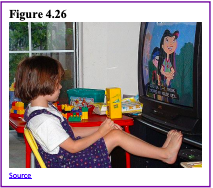
An additional concern is the amount of screen time children are getting with smart mobile devices. While most parents believe that their young children use mobile devices for a variety of activities, the children report that they typically use them to play games (Chiong & Schuler, 2010). Studies have reported that young children who have two or more hours per day using mobile devices show more externalizing behaviors (aggression, tantrums) and inattention (Tamana, et al., 2019), shorter sleep duration and a higher risk of behavioral problems (Wu, 2017), and fail to meet developmental milestones in fine and gross motor skills, language, and problem-solving (Madigan, Browne, Racine, Mori, & Tough, 2019).
Based on research findings, the AAP (2016) suggests that prior to the age of two children should be engaged in hands-on exploration and social interaction with the real world, rather than the virtual one. The immaturity of the cognitive functions in infants and toddlers make it difficult for them to learn from digital media as effectively as they can from caregivers. For instance, it is often not until 24 months of age that children can learn new words from live-video chatting (Kirkorian, Choi, & Pempek, 2016). Between the ages of 2 and 5 the AAP (2016) suggests that children should be limited to no more than one hour per day of high quality programs that are co- viewed with a caregiver to help children to understand what they are viewing. The AAP also strongly suggest that parents should avoid using mobile media to soothe their children. The concern is that using media as a strategy to distract or soothe the child may make it difficult for parents to limit the child’s use of the devices and may inhibit children’s ability to self-regulate their own emotions.
Child Care
In 2018, about 71.5% of mothers of school-aged and 65.1% percent of mothers of preschool aged children in the United States worked outside the home (Bureau of Labor Statistics, 2019). Since more women have been entering the workplace, there has been a concern that families do not spend as much time with their children. This, however, is not true. The Economist Data Team (2017) analyzed data from of ten countries (United States, Britain, Canada, France, Germany, Denmark, Italy, Netherlands, Slovenia and Spain) and estimated that the average mother spent 54 minutes a day caring for children in 1965, but 104 minutes in 2012. Only mothers in France spent last time in 2012 than in 1965. Men continue to do less than women at 59 minutes per day in 2012, but they provided more care than in 1965 when they averaged only 16 minutes a day. However, differences were found between working-class and middle-class mothers. In 1965 mothers with and without a university education spent about the same amount of time on child care. By 2012 the more educated ones were spending half an hour more per day. See Figure 4.27 for the difference between mothers in the United States who were university educated (dark blue line) and those who were non-university educated (light blue line).
Figure 4.27 U.S. Mothers’ Time Spent in Child Care
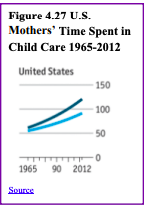
To evaluate how early child care affects children’s development, the National Institute of Child Health and Human Development (2006) conducted a longitudinal study. This study is considered the most comprehensive child care study to date, and it began in 1991 when the children were one month of age. The study included an economically and ethnically diverse group of 1364 children assessed from 10 sites around the country. By design the study involved single parents, minority backgrounds, and differing formal education levels. Child care was defined as “any care provided on a regular basis by someone other than the child’s mother” (p. 4). A regular basis included more than 10 hours per week. Child care arrangements included: Care from the father or another relative, care from a caregiver not related to the child in the child’s home, small group care in the caregiver’s home, and center-based care.
Overall results indicated that children cared for by their mothers did not develop differently than those who were cared for by others. Parents and family characteristics were stronger predictors of child development than child care facilities. Specifically, greater cognitive, language and social competence were demonstrated when parents were more educated, had higher incomes, and provided emotionally supportive and cognitively enriched home environments. When comparing higher quality child care with lower quality child care differences were noted. Higher quality care, as measured by adult-to-child ratios, group size, and caregivers’ educational and training levels, resulted in higher cognitive performance, better language comprehension and production, and higher levels of school readiness. Lower quality care predicted more behavioral problems and poorer cognitive, language, and school readiness.
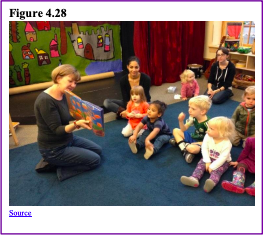
The higher the teacher to child ratio, the more time the teacher has for involvement with the children and the less stressed the teacher may be so that the interactions can be more relaxed, stimulating and positive. The more children there are in a program, the less desirable the program as well. This is because the center may be more rigid in rules and structure to accommodate the large number of children in the facility. The physical environment should be colorful, stimulating, clean, and safe. The philosophy of the organization and the curriculum available should be child-centered, positive, and stimulating. Providers should be trained in early childhood education as well. A majority of states do not require training for their child care providers. While formal education is not required for a person to provide a warm, loving relationship to a child, knowledge of a child’s development is useful for addressing their social, emotional, and cognitive needs in an effective way.
By working toward improving the quality of childcare and increasing family-friendly workplace policies, such as more flexible scheduling and childcare facilities at places of employment, we can accommodate families with smaller children and relieve parents of the stress sometimes associated with managing work and family life.
Child Abuse
The Child Abuse Prevention and Treatment Act (United States Department of Health and Human Services, 2013) defines Child Abuse and Neglect as: Any recent act or failure to act on the part of a parent or caretaker which results in death, serious physical or emotional harm, sexual abuse or exploitation; or an act or failure to act, which presents an imminent risk of serious harm (p. viii). Each state has its own definition of child abuse based on the federal law, and most states recognize four major types of maltreatment: neglect, physical abuse, psychological maltreatment, and sexual abuse. Each of the forms of child maltreatment may be identified alone, but they can occur in combination.
Victims of Child Abuse: According to the United States Department of Health and Human Services (HHS) (2019), during 2017 (the most recent year data has been collected) Child Protective Services (CPS) agencies received an estimated 4.1 million referrals for abuse involving approximately 7.5 million children. This is a rate of 31.8 per 1,000 children in the national population. Professionals made 65.7% of alleged child abuse and neglect reports, and they included law enforcement (18.3%), educational (19.4%) and social services personnel (11.7%). Nonprofessionals, such as friends, neighbors, and relatives, submitted 17.3% of the reports. Approximately 3.5 million children were the subjects of at least one report.
Victims in their first year of life had the highest rate of victimization (25.3 per 1,000 children of the same age). The majority of victims consisted of three ethnicities: White (44.6%), Hispanic (22.3%), and African-American (20.7%). The greatest percentages of children suffered from neglect (74.9%) and physical abuse (18.3%), although a child may have suffered from multiple forms of maltreatment. In 2017 an estimated 1,720 children died from abuse and neglect, and 71.8% of all child fatalities were younger than 3 years old. Boys had a higher child fatality rate (2.68 per 100,000 boys), while girls died of abuse and neglect at a rate of 2.02 per 100,000 girls. More than 88% of child fatalities were comprised of White (41.9%), African-American (31.5%), and Hispanic (15.1%) victims (HHS, 2019).
Sexual Abuse: Childhood sexual abuse is defined as any sexual contact between a child and an adult or a much older child. Incest refers to sexual contact between a child and family members. In each of these cases, the child is exploited by an older person without regard for the child’s developmental immaturity and inability to understand the sexual behavior (Steele, 1986). Research estimates that 1 out of 4 girls and 1 out of 10 boys have been sexually abused (Valente, 2005). The median age for sexual abuse is 8 or 9 years for both boys and girls (Finkelhorn, Hotaling, Lewis, & Smith, 1990). Most boys and girls are sexually abused by a male. Although rates of sexual abuse are higher for girls than for boys, boys may be less likely to report abuse because of the cultural expectation that boys should be able to take care of themselves and because of the stigma attached to homosexual encounters (Finkelhorn et al., 1990). Girls are more likely to be abused by family member and boys by strangers. Sexual abuse can create feelings of self-blame, betrayal, shame and guilt (Valente, 2005). Sexual abuse is particularly damaging when the perpetrator is someone the child trusts and may lead to depression, anxiety, problems with intimacy, and suicide (Valente, 2005).
Stress on Young Children: Children experience different types of stressors. Normal, everyday stress can provide an opportunity for young children to build coping skills and poses little risk to development. Even more long-lasting stressful events, such as changing schools or losing a loved one, can be managed fairly well. Children who experience toxic stress or who live in extremely stressful situations of abuse over long periods of time can suffer long-lasting effects. The structures in the midbrain or limbic system, such as the hippocampus and amygdala, can be vulnerable to prolonged stress during early childhood (Middlebrooks & Audage, 2008). High levels of the stress hormone cortisol can reduce the size of the hippocampus and affect the child’s memory abilities. Stress hormones can also reduce immunity to disease. The brain exposed to long periods of severe stress can develop a low threshold making the child hypersensitive to stress in the future.
Adverse Childhood Experiences (ACEs)
The toxic stress that young children endure can have a significant impact on their later lives. According to Merrick, Ford, Ports, and Guinn (2018), the foundation for lifelong health and well-being is created in childhood, as positive experiences strengthen biological systems while adverse experiences can increase mortality and morbidity. All types of abuse, neglect, and other potentially traumatic experiences that occur before the age of 18 are referred to as adverse childhood experiences (ACEs) (CDC, 2019). ACEs have been linked to risky behaviors, chronic health conditions, low life potential and early death, and as the number of ACEs increase, so does the risk for these results.
Figure 4.29
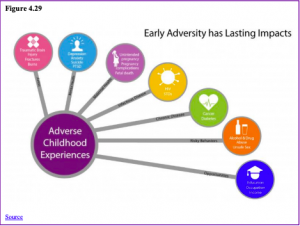
When a child experiences strong, frequent, and/or prolonged adversity without adequate adult support, the child’s stress response systems can be activated and disrupt the development of the brain and other organ systems (Harvard University, 2019). Further, ACEs can increase the risk for stress-related disease and cognitive impairment, well into the adult years. Felitti et al. (1998) found that those who had experienced four or more ACEs compared to those who had experienced none, had increased health risks for alcoholism, drug abuse, depression, suicide attempt, increase in smoking, poor self-rated health, more sexually transmitted diseases, an increase in physical inactivity and severe obesity. More ACEs showed an increased relationship to the presence of adult diseases including heart disease, cancer, chronic lung disease, skeletal fractures, and liver disease. Overall, those with multiple ACEs were likely to have multiple health risk factors later in life.
Figure 4.30 How ACES Affect Children and Adults
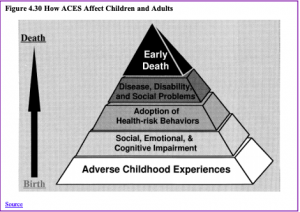
Some groups have been found to be at a greater risk for experiencing ACEs. Merrick et al. (2018) reviewed the results from the 2011-2014 Behavioral Risk Factor Surveillance System, which included an ACE module consisting of questions adapted from the Centers for Disease Control and Prevention. Each question was collapsed into one of the eight ACE categories: physical abuse, emotional abuse, sexual abuse, household mental illness, household substance use, household domestic violence, incarcerated household member, and parental separation or divorce. The results indicated that 25% of the sample had been exposed to three or more ACEs, and although ACEs were found across all demographic groups, those who identified as Black, multiracial, lesbian/gay/bisexual, having less than a high school education, being low income, and unemployed experienced significantly higher ACE exposure. Assisting families and providing children with supportive and responsive adults can help prevent the negative effects of ACEs.
Separating Families at the United States Border: Thousands of children were separated from their parents beginning in April 2018 as they approached the United States border by Immigration and Custom Enforcement (ICE). Children were placed in separate facilities from their parents when they were being processed, and they were not told when they would be reunited. When enduring stressful situations, separation from one’s parents can be extremely detrimental to a child (Society for Research in Child Development (SRCD), 2018). Parental separations affect children’s stress management systems by changing how the body responds to stress. Long-term stress can disrupt brain functioning, cognitive skills, emotional processing, and physiological health. When exposed to stress, children typically look to their parents for support and care, and parents can reduce children’s stress. These separated children were already under extreme stress escaping their previous homes, and then were separated from the individuals who could support them through this process.

Stress from parent separation places children at a higher risk for anxiety, depression, PTSD, lower IQ, obesity, impaired immune system functioning, and medical conditions (SRCD, 2018). Even after being reunited, children can experience attachment issues, poorer self-esteem, and physical and psychological health difficulties. As they age, they continue to exhibit an increased risk for mental health problems, problems in social interactions, difficulty with adult attachments, poorer stress management, and an increased risk for death. The American Psychological Association (2019) opposes policies that separate families given the negative outcomes suffered by children.
References
Abuhatoum, S., & Howe, N. (2013). Power in sibling conflict during early and middle childhood. Social Development, 22, 738- 754.
Al-Haddad, B., Jacobsson, B., Chabra, S., Modzelewska, D., Olson, E……. Sengpiel, V. (2019). Long-term risk of neuropsychiatric disease after exposure to infection in utero. JAMA Psychiatry, 76(6), 594-602.
American Academy of Pediatrics. (2015). Gender identity development in children. Retrieved from https://www.healthychildren.org/English/ages-stages/ gradeschool/Pages/Gender-Identity-and-Gender-Confusion-In- Children.aspx
American Academy of Pediatrics. (2016). Media and young minds. Retrieved from https://pediatrics.aappublications.org/content/138/5/e20162591
American Psychiatric Association. (2013). Diagnostic and statistical manual of mental disorders, 5th edition (DSM-5). Washington, DC: Author.
American Psychological Association. (2019). Immigration. Retrieved from https://www.apa.org/advocacy/immigration
Ariès, P. (1962). Centuries of childhood: A social history of family life. New York: Knopf.
Armor, D. J. (2015). Head Start or false start. USA Today Magazine. Retrieved from https://www.questia.com/magazine/1G1-429736352/head-start-or-false-start
Autism Genome Project Consortium. (2007). Mapping autism risk loci using genetic linkage and chromosomal rearrangements. Nature Genetics, 39, 319–328.
Baio, J., Wiggins, L., Christensen, D., Maenner, M., ……. Dowling, N. (2018). Prevalence of autism spectrum disorder among children aged 8 years-autism and developmental disabilities monitoring network, 11 sites, United States, 2014. MMWR Surveillance Summary, 67(No. SS-6), 1-23. doi: http://dx.doi.org/a0.15585/mmwr.ss6706a1External
Bandura, A. (1997). Self-efficacy: The exercise of control. New York: Freeman.
Barshay, J. (2015). Report: Scant scientific evidence for Head Start programs’ effectiveness. U.S. News and World Report. Retrieved from http://www.usnews.com/news/articles/ 2015/08/03/report-scant-scientific-evidence-for-head-start- programs-effectiveness
Baumrind, D. (1971). Current patterns of parental authority. Developmental Psychology Monograph, 4(1), part 2.
Baumrind, D. (2013). Authoritative parenting revisited: History and current status. In R. E. Larzelere, A. Sheffield, & A. W. Harrist (Eds.). Authoritative parenting: Synthesizing nurturance and discipline for optimal child development (pp. 11- 34). Washington, DC: American Psychological Association.
Bem, S. L. (1981). Gender schema theory: A cognitive account of sex typing. Psychological Review, 88, 354-364. Berk, L. E. (2007). Development through the life span (4th ed.). Boston: Allyn and Bacon.
Berwid, O., Curko-Kera, E. A., Marks, D. J., & Halperin, J. M. (2005). Sustained attention and response inhibition in young children at risk for attention deficit hyperactivity disorder. Journal of Child Psychology and Psychiatry, 46(11), 1219- 1229.
Bialystok, E. (2011). Coordination of executive functions in monolingual and bilingual children. Journal of Experimental Child Psychology, 110, 461–468.
Bialystok, E., Martin, M.M., & Viswanathan, M. (2005). Bilingualism across the lifespan: The rise and fall of inhibitory control. International Journal of Bilingualism, 9, 103–119.
Bibok, M.B., Carpendale, J.I.M., & Muller, U. (2009). Parental scaffolding and the development of executive function. New Directions for Child and Adolescent Development, 123, 17-34.
Bigler, R. S., & Liben, L. S. (2007). Developmental intergroup theory: Exploring and reducing children’s social stereotyping and prejudice. Current Directions in Psychological Science, 16, 162-166.
Birch, S., & Bloom, P. (2003). Children are cursed: An asymmetric bias in mental-state attribution. Psychological Science, 14(3), 283-286.
Blackless, M., Charuvastra, A., Derryck, A., Fausto-Sterling, A., Lauzanne, K., & Lee, E. (2000). How sexually dimorphic are we? Review and synthesis. American Journal of Human Biology, 12, 151-166.
Bonifacci, P., Giombini, L., Beloocchi, S., & Conteno, S. (2011). Speed of processing, anticipation, inhibition and working memory in bilinguals. Developmental Science, 14, 256–269.
Boyse, K. & Fitgerald, K. (2010). Toilet training. University of Michigan Health System. Retrieved from http://www.med.umich.edu/yourchild/topics/toilet.htm
Brody, G. H., Stoneman, Z., & McCoy, J. K. (1994). Forecasting sibling relationships in early adolescence from child temperament and family processes in middle childhood. Child development, 65, 771-784.
Brown, G.L., Mangelsdork, S.C., Agathen, J.M., & Ho, M. (2008). Young children’s psychological selves: Convergence with maternal reports of child personality. Social Development, 17, 161-182.
Bureau of Labor Statistics. (2019). Employment characteristics of families-2018. Retrieved from https://www.bls.gov/news.release/pdf/famee.pdf
Bussey, K., & Bandura, A. (1999). Social cognitive theory of gender development and differentiation. Psychological Review, 106(4), 676-713.
Byrd, R. (2002). Report to the legislature on the principal findings from the epidemiology of autism in California: A comprehensive pilot study. Retrieved from http://www.dds.ca.gov/Autism/MindReport.cfm
Camarota, S. A., & Zeigler, K. (2015). One in five U. S. residents speaks foreign language at home. Retrieved from https://cis.org/sites/default/files/camarota-language-15.pdf
Carroll, J. L. (2007). Sexuality now: Embracing diversity (2nd ed.). Belmont, CA: Thomson.
Centers for Disease Control and Prevention. (2000). 2000 CDC Growth Charts for the United States: Methods and Development. Retrieved from http://www.cdc.gov/nchs/data/series/sr_11/sr11_246.pdf
Centers for Disease Control and Prevention. (2012). Prevalence of autism spectrum disorders, autism and developmental disabilities monitoring network, 14 sites, United States, 2008. Morbidity and Mortality Weekly Report: Surveillance Summaries, 61(3), 1–19. Retrieved from http://www.cdc.gov/mmwr/pdf/ss/ss6103.pdf
Centers for Disease Control and Prevention. (2015). Nutrition and health of young people. Retrieved from http://www.cdc.gov/healthyschools/nutrition/facts.htm
Centers for Disease Control and Prevention. (2019). About adverse childhood experiences. Retrived from https://www.cdc.gov/violenceprevention/childabuseandneglect/acestudy/aboutace.html
Chang, A., Sandhofer, C., & Brown, C. S. (2011). Gender biases in early number exposure to preschool-aged children. Journal of Language and Social Psychology, 30(4), 440-450.
Chiong, C., & Shuler, C. (2010). Learning: Is there an app for that? Investigations of young children’s usage and learning with mobile devices and apps. New York: The Joan Ganz Cooney Center at Sesame Workshop. Retrieved from: https://clalliance.org/wp-content/uploads/files/learningapps_final_110410.pdf
Christakis, D.A. (2009). The effects of infant media usage: What do we know and what should we learn? Acta Paediatrica, 98, 8–16.
Clark, J. (1994). Motor development. In V. S. Ramachandran (Ed.), Encyclopedia of human behavior (pp. 245–255). San Diego: Academic Press.
Colwell, M.J., & Lindsey, E.W. (2003). Teacher-child interactions and preschool children’s perceptions of self and peers. Early Childhood Development & Care, 173, 249-258.
Coté, C. A., & Golbeck, S. (2007). Preschoolers’ feature placement on own and others’ person drawings. International Journal of Early Years Education, 15(3), 231-243.
Courage, M.L., Murphy, A.N., & Goulding, S. (2010). When the television is on: The impact of infant-directed video on 6- and 18-month-olds’ attention during toy play and on parent-infant interaction. Infant Behavior and Development, 33, 176- 188.
Crain, W. (2005). Theories of development concepts and applications (5th ed.). New Jersey: Pearson.
De Houwer, A. (2007). Parental language input patterns and children’s bilingual use. Applied Psycholinguistics, 28, 411–422
DeStefano, F., Price, C. S., & Weintraub, E. S. (2013). Increasing exposures to antibody-stimulating proteins and polysaccharides in vaccines is not associated with risk of autism. The Journal of Pediatrics, 163, 561–567.
Dougherty, D.M., Marsh, D.M., Mathias, C.W., & Swann, A.C. (2005). The conceptualization of impulsivity: Bipolar disorder and substance abuse. Psychiatric Times, 22(8), 32-35.
Dunn, J., & Munn, P. (1987). Development of justification in disputes with mother and sibling. Developmental Psychology, 23, 791-798.
Dyer, S., & Moneta, G. B. (2006). Frequency of parallel, associative, and cooperative play in British children of different socio- economic status. Social Behavior and Personality, 34(5), 587-592.
Economist Data Team. (2017). Parents now spend twice as much time with their children as 50 years ago. Retrieved from https://www.economist.com/graphic-detail/2017/11/27/parents-now-spend-twice-as-much-time-with-their-children-as- 50-years-ago
Epley, N., Morewedge, C. K., & Keysar, B. (2004). Perspective taking in children and adults: Equivalent egocentrism but differential correction. Journal of Experimental Social Psychology, 40, 760–768.
Erikson, E. (1982). The life cycle completed. NY: Norton & Company.
Evans, D. W., Gray, F. L., & Leckman, J. F. (1999). The rituals, fears and phobias of young children: Insights from development, psychopathology and neurobiology. Child Psychiatry and Human Development, 29(4), 261-276. doi:10.1023/A:1021392931450
Evans, D. W. & Leckman, J. F. (2015) Origins of obsessive-compulsive disorder: Developmental and evolutionary perspectives. In D. Cicchetti and D. J. Cohen (Eds.), Developmental psychopathology (2nd edition). Hoboken, NJ: Wiley & Sons. doi: 10.1002/9780470939406.ch10
Fay-Stammbach, T., Hawes, D. J., & Meredith, P. (2014). Parenting influences on executive function in early childhood: A review. Child Development Perspectives, 8(4), 258-264.
Felitti, V. J., Anda, R.F., Nordenberg, D., Williamson, D. F., Spitz, A., Edwards, V., Koss, M. P., & Marks, J. S. (1998).
Relationship of childhood abuse and household dysfunction to many of the leading causes of death in adults: The Adverse Childhood Experiences (ACE) Study. American Journal of Preventive Medicine, 14(4), 245-258. doi:10.1016/S0749-3797(98)00017-8
Finkelhorn, D., Hotaling, G., Lewis, I. A., & Smith, C. (1990). Sexual abuse in a national survey of adult men and women: Prevalence, characteristics, and risk factors. Child Abuse and Neglect, 14(1), 19-28.
Frank, G., Plunkett, S. W., & Otten, M. P. (2010). Perceived parenting, self-esteem, and general self-efficacy of Iranian American adolescents. Journal of Child & Family Studies, 19, 738-746.
Galotti, K. M. (2018). Cognitive psychology: In and out of the laboratory (6th Ed.). Thousand Oaks, CA: Sage. Garrett, B. (2015). Brain and behavior: An introduction to biological psychology (4th Ed.). Thousand Oaks, CA: Sage.
Gauthier, J., Siddiqui, T. J., Huashan, P., Yokomaku, D., Hamdan, F. F., Champagne, N., . . . Rouleau, G.A. (2011). Truncating mutations in NRXN2 and NRXN1 in autism spectrum disorders and schizophrenia. Human Genetics, 130, 563–573.
Gecas, V., & Seff, M. (1991). Families and adolescents. In A. Booth (Ed.), Contemporary families: Looking forward, looking back. Minneapolis, MN: National Council on Family Relations.
Gentile, D.A., & Walsh, D.A. (2002). A normative study of family media habits. Applied Developmental Psychology, 23, 157- 178.
Gernhardt, A., Rubeling, H., & Keller, H. (2015). Cultural perspectives on children’s tadpole drawings: At the interface between representation and production. Frontiers in Psychology, 6, Article 812. doi: 0.3389/fpsyg.2015.00812.
Gershoff, E. T. (2008). Report on physical punishment in the United States: What research tell us about its effects on children. Columbus, OH: Center for Effective Discipline.
Glass, E., Sachse, S., & von Suchodoletz, W. (2008). Development of auditory sensory memory from 2 to 6 years: An MMN study. Journal of Neural Transmission, 115(8), 1221-1229.doi:10.1007/s00702-008-0088-6
Gleason, T. R. (2002). Social provisions of real and imaginary relationships in early childhood. Developmental Psychology, 38, 979-992.
Gleason, T. R., & Hohmann, L. M. (2006). Concepts of real and imaginary friendships in early childhood. Social Development, 15, 128-144.
Gleason, T. R., Sebanc, A. M., & Hartup, W. W. (2000). Imaginary companions of preschool children. Developmental Psychology, 36(4), 419-428.
Gomes, G. Sussman, E., Ritter, W., Kurtzberg, D., Vaughan, H. D. Jr., & Cowen, N. (1999). Electrophysiological evidence of development changes in the duration of auditory sensory memory. Developmental Psychology, 35, 294-302.
Goodvin, R., Meyer, S. Thompson, R.A., & Hayes, R. (2008). Self-understanding in early childhood: Associations with child attachment security and maternal negative affect. Attachment & Human Development, 10(4), 433-450.
Gopnik, A., & Wellman, H.M. (2012). Reconstructing constructivism: Causal models, Bayesian learning mechanisms, and the theory theory. Psychological Bulletin, 138(6), 1085-1108.
Guy, J., Rogers, M., & Cornish, K. (2013). Age-related changes in visual and auditory sustained attention in preschool-aged children. Child Neuropsychology, 19(6), 601–614. Retrieved from http://dx.doi.org/10.1080/09297049.2012.710321
Hammer C. S., Hoff, E., Uchikosh1, Y., Gillanders, C., Castro, D., & Sandilos, L. E. (2014). The language literacy development of young dual language learners: A critical review. Early Child Research Quarterly, 29(4), 715-733.
Harter, S., & Pike, R. (1984). The pictorial scale of Perceived Competence and Social Acceptance for Young Children. Child Development, 55, 1969-1982.
Harvard University. (2019). Center on the developing child: Toxic stress. Retrieved from https://developingchild.harvard.edu/science/key-concepts/toxic-stress/
Herrmann, E., Misch, A., Hernandez-Lloreda, V., & Tomasello, M. (2015). Uniquely human self-control begins at school age. Developmental Science, 18(6), 979-993. doi:10.1111/desc.12272.
Herrmann, E., & Tomasello, M. (2015). Focusing and shifting attention in human children (homo sapiens) and chimpanzees (pan troglodytes). Journal of Comparative Psychology, 129(3), 268–274. Retrieved from http://dx.doi.org/10.1037/a0039384
Hoff, E. (2018). Bilingual development in children of immigrant families. Child Development Perspectives, 12(2), 80-86.
Howe, N., Rinaldi, C. M., Jennings, M., & Petrakos, H. (2002). “No! The lambs can stay out because they got cozies”: Constructive and destructive sibling conflict, pretend play, and social understanding. Child Development, 73, 1406- 1473.
Hughes, V. (2007). Mercury rising. Nature Medicine, 13, 896-897.
Imai, M., Li, L., Haryu, E., Hirsh-Pasek, K., Golinkoff, R. M., & Shigematsu, J. (2008). Novel noun and verb learning in Chinese, English, and Japanese children: Universality and language-specificity in novel noun and verb learning. Child Development, 79, 979-1000.
Jarne, P., & Auld, J. R. (2006). Animals mix it up too: The distribution of self-fertilization among hermaphroditic animals. Evolution, 60, 1816–1824.
Jones, P.R., Moore, D.R., & Amitay, S. (2015). Development of auditory selective attention: Why children struggle to hear in noisy environments. Developmental Psychology, 51(3), 353–369. Retrieved from http://dx.doi.org/10.1037/a0038570
Kalat, J. W. (2016). Biological Psychology (12th Ed.). Boston, MA: Cengage.
Kaushanskaya, M., Gross, M., & Buac, M. (2014). Effects of classroom bilingualism on task-shifting, verbal memory, and word learning in children. Developmental Science, 17(4), 564-583.
Kellogg, R. (1969). Handbook for Rhoda Kellogg: Child art collection. Washington D. C.: NCR/Microcard Editions.
Kemple, K.M., (1995). Shyness and self-esteem in early childhood. Journal of Humanistic Education and Development, 33(4), 173-182.
Kimmel, M. S. (2008). The gendered society (3rd ed.). Oxford: Oxford University Press.
Kinney, D. K., Barch, D. H., Chayka, B., Napoleon, S., & Munir, K. M. (2009). Environmental risk factors for autism: Do they help or cause de novo genetic mutations that contribute to the disorder? Medical Hypotheses, 74, 102–106.
Kirkorian, H.L., Choi, K., & Pempek, T.A. (2016). Toddlers’ word learning from contingent and noncontingent video on touch screens. Child Development, 87(2), 405–413.
Kirkorian, H.L., Pempek, T.A., & Murphy, L.A. (2009). The impact of background television on parent-child interaction. Child Development, 80, 1350-1359.
Knorr, C. (2017). Gender stereotypes are messing with your kid. Retrieved from https://www.commonsensemedia.org/blog/gender-stereotypes-are-messing-with-your-kid
Kohn, M. L. (1977). Class and conformity. (2nd ed.). Chicago: University of Chicago Press.
Kolb, B. & Whishaw, I. Q. (2011). An introduction to brain and behavior (3rd ed.). New York: Worth Publishers.
Kramer, L., & Gottman, J. M. (1992). Becoming a sibling: “With a little help from my friends.” Developmental Psychology, 28, 685-699.
Lenroot, R. K., & Giedd, J. N. (2006). Brain development in children and adolescents: Insights from anatomical magnetic resonance imaging. Neuroscience and Biobehavioral Reviews, 30, 718-729.
Maccoby, E., & Jacklin, C. (1987). Gender segregation in childhood. Advances in Child Development and Behavior, 20, 239-287.
MacKenzie, M. J., Nicklas, E., Waldfogel, J., & Brooks-Gunn, J. (2013). Spanking and child development across the first decade of life. Pediatrics, 132(5), e1118-e1125.
Madigan, S., Browne, D., Racine, N., Mori, C., & Tough, S. (2019). Association between screen time and children’s performance on a developmental screening test. JAMA Pediatrics, 173(3), 244-250.
Manosevitz, M., Prentice, N. M., & Wilson, F. (1973). Individual and family correlates of imaginary companions in preschool children. Developmental Psychology, 8, 72-79.
Martinson, F. M. (1981). Eroticism in infancy and childhood. In L. L. Constantine & F. M. Martinson (Eds.), Children and sex: New findings, new perspectives. (pp. 23-35). Boston: Little, Brown.
Masih, V. (1978). Imaginary play companions of children. In R. Weizman, R. Brown, P. Levinson, & P. Taylor (Eds.). Piagetian theory and the helping profession (pp. 136-144). Los Angeles: University of Southern California Press.
Mauro, J. (1991). The friend that only I can see: A longitudinal investigation of children’s imaginary companions. Dissertation, University of Oregon.
Mayo Clinic Staff. (2016a). Nutrition for kids: Guidelines for a healthy diet. Retrieved from http://www.mayoclinic.org/healthy- lifestyle/childrens-health/in-depth/nutrition-for-kids/art-20049335
Mayo Clinic Staff. (2016b). Potty training: How to get the job done. Retrieved from http://www.mayoclinic.org/healthy- lifestyle/infant-and-toddler-health/indepth/potty-training/art-20045230
McAlister, A. R., & Peterson, C. C. (2007). A longitudinal study of siblings and theory of mind development. Cognitive Development, 22, 258-270.
Meek, S. E., Lemery-Chalfant, K., Jahromi, L. D., & Valiente, C. (2013). A review of gene-environment correlations and their implications for autism: A conceptual model. Psychological Review, 120, 497–521.
Merrick, M. T., Ford, D. C., Ports, K. A., & Guinn, A. S. (2018). Prevalence of adverse childhood experiences from the 2011- 2014 Behavioral Risk Factor Surveillance System in 23 States. Early JAMA Pediatrics, 172(11), 1038-1044.
Meyers-Sutton, C. (2005). Multiple voices: An introduction ot bilingualism. Malden, MA: Blackwell Publishers.
Middlebrooks, J. S., & Audage, N. C. (2008). The effects of childhood stress on health across the lifespan. (United States, Center for Disease Control, National Center for Injury Prevention and Control). Atlanta, GA.
Mischel, W., Ayduk, O., Berman, M. G., Casey, B. J., Gotlib, I. H., Jonides, J., & … Shoda, Y. (2011). ‘Willpower’ over the life span: Decomposing self-regulation. Social Cognitive & Affective Neuroscience, 6(2), 252-256. doi:10.1093/scan/nsq081
Mischel, W., Ebbesen, E. B., & Zeiss, A. R. (1972). Cognitive and attentional mechanisms in delay of gratification. Journal of Personality and Social Psychology, 21, 204–218.
Morra, S., Gobbo, C., Marini, Z., & Sheese, R. (2008). Cognitive development: Neo-Piagetian perspectives. New York: Lawrence Erlbaum Associates.
National Association for the Education of Young Children. (2016). The 10 NAEYC program standards. Retrieved from http://families.naeyc.org/accredited-article/10-naeyc-program-standards
National Institute of Child Health and Human Development. (2006). The NICHD study of early child care (NIH Pub. No. 05- 4318). Washington, DC: Government Printing Office.
Nelson, K., & Fivush, R. (2004). The emergence of autobiographical memory: A social cultural developmental theory. Psychological Review, 111(2), 468-511.
Nelson, K., & Ross, G. (1980). The generalities and specifics of long-term memory in infants and young children. In M. Perlmutter (Ed.), Children’s memory: New directions in child development (Vol. 10, pp. 87-101). San Francisco: Jossey-Bass.
Nielsen Company. (2009). Television audience 2008-2009. Retrieved from http://blog.nielsen.com/nielsenwire/wp-content/uploads/2009/07/tva_2008_071709.pdf
Novella, S. (2008). The increase in autism diagnoses: Two hypotheses [Web log post]. Retrieved from http://www.sciencebasedmedicine.org/the-increase-in-autism-diagnoses-two-hypotheses/
Okami, P., Olmstead, R., & Abramson, P. R. (1997). Sexual experiences in early childhood: 18-year longitudinal data from UCLA Family Lifestyles Project. Journal of Sex Research, 34(4), 339-347.
Olson, K. R., & Gülgöz, S. (2018). Early findings from the TransYouth Project: Gender development in transgender children. Child Development Perspectives, 12(2), 93-97.
Parten, M. B. (1932). Social participation among preschool children. Journal of Abnormal and Social Psychology, 27, 243-269. Perner, J., Ruffman, T., & Leekam, S. R. (1994). Theory of mind is contagious: You catch from your sibs. Child Development, 65, 1228-1238.
Pike, A., Coldwell, J., & Dunn, J. F. (2005). Sibling relationships in early/middle childhood: Links with individual adjustment. Journal of Family Psychology, 19(4), 523-532.
Place, S., & Hoff, E. (2016). Effects and non-effects of input in bilingual environments on dual language skills in 2 1/2-year-olds. Bilingualism: Language and Cognition, 19, 1023–1041.
Porporino, M., Shore, D.I., Iarocci, G., & Burack, J.A. (2004). A developmental change in selective attention and global form perception. International Journal of Behavioral Development, 28 (4), 358–364 doi:10.1080/01650250444000063
Posner, M.I., & Rothbart, M.K. (2007). Research on attention networks as a model for the integration of psychological science. Annual Review in Psychology, 58, 1–23
Price-Williams, D.R., Gordon, W., & Ramirez, M. (1969). Skill and conservation: A study of pottery making children. Developmental Psychology, 1, 769.
Ram, A., & Ross, H. (2008). “We got to figure it out”: Information-sharing and siblings’ negotiations of conflicts of interest. Social Development, 17, 512-527.
Rice, F. P. (1997). Human development: A life-span approach. Upper Saddle River, NJ: Prentice Hall. Rideout, V.J., & Hamel E. (2006). The media family: Electronic media in the lives of infants, toddlers, preschoolers and their parents. Retrieved from http://www.kff.org/entmedia/upload/7500.pdf
Robinson, T.N., Wilde, M.L., & Navracruz, L.C. (2001). Effects of reducing children’s television and video game use on aggressive behavior: A randomized controlled trial. Archives of Pediatrics and Adolescent Medicine, 155, 17-23.
Rothbart, M.K., & Rueda, M.R. (2005). The development of effortful control. In U. Mayr, E. Awh, & S.W. Keele (Eds.), Developing individuality in the human brain: A festschrift honoring Michael I. Posner (pp. 167–88). Washington, DC: American Psychological Association
Ruble, D.N., Boggiano, A.K., Feldman, N.S., & Loeble, J.H. (1980). Developmental analysis of the role of social comparison in self-evaluation. Developmental Psychology, 16, 105-115.
Ruble, D. N., Martin, C., & Berenbaum, S. (2006). Gender development. In W. Damon & R. M. Lerner (Series Eds.) & N. Eisenberg (Vol. Ed.), Handbook of child psychology: Vol. 3. Social, emotional, and personality development (6th ed., pp. 858–932). New York, NY: Wiley.
Russo, F. (2016). Debate growing about how to meet the urgent needs of transgender kids. Scientific American Mind, 27(1), 27- 35.
Ryan, C. (2013). Language use in the United States: 2011. Retrieved from https://www2.census.gov/library/publications/2013/acs/acs-22/acs-22.pdf
Save the Children. (2019). Child protection. Retrived from https://www.savethechildren.net/what-we-do/child-protection
Schmidt, M.E., Pempek, T.A., & Kirkorian, H.L. (2008). The effects of background television on the toy play behavior of very young children. Child Development, 79, 1137-1151.
Schneider, W., Kron-Sperl, V., & Hunnerkopf, M. (2009). The development of young children’s memory strategies: Evidence from the Würzburg longitudinal memory study. European Journal of Developmental Psychology, 6(1), 70-99.
Schwartz, I. M. (1999). Sexual activity prior to coitus initiation: A comparison between males and females. Archives of Sexual Behavior, 28(1), 63-69.
Shahaeian, A., Peterson, C. C., Slaughter, V., & Wellman, H. M. (2011). Culture and the sequence of steps in theory of mind development. Developmental Psychology, 47(5), 1239-1247.
Singer, D., & Singer, J. (1990). The house of make-believe. Cambridge, MA: Harvard University Press.
Smith, B. L. (2012). The case against spanking. Monitor on Psychology, 43(4), 60.
Society for Research in Child Development. (2018). The Science is clear: Separating families has long-term damaging psychological and health consequences for children, families, and communities. Retrieved from https://www.srcd.org/policy-media/statements-evidence
Spears Brown, C., & Jewell, J. A. (2018). Gender. Retrieved from https://nobaproject.com/modules/gender
Steele, B.F. (1986). Notes on the lasting effects of early child abuse throughout the life cycle. Child Abuse & Neglect 10(3), 283-291.
Tamana, S.K., Ezeugwu, E., Chikuma, J., Lefebvre, D.L., Azad, M.B., Moraes, T.J.,… & Mandhane, P. J. (2019). Screen-time is associated with inattention problems in preschoolers: Results from the CHILD birth cohort study. PLOS ONE, 14(4), e0213995. Retrieved from https://journals.plos.org/plosone/article?id=10.1371/journal.pone.0213995
Thomas, R. M. (1979). Comparing theories of child development. Santa Barbara, CA: Wadsworth.
Traverso, L., Viterbori, P., & Usai, M. C. (2015). Improving executive function in childhood: Evaluation of a training intervention for 5-year-old children. Frontiers in Psychology, 6, 1-14. doi:10.3389/fpsyg.2015.00525
United Nations. (2014). Committee on the rights of the child. Retrieved from http://tbinternet.ohchr.org/Treaties/CRC/Shared%20Documents/VAT/CRC_C_VAT_CO_2_16302_E.pdf
United States Department of Health and Human Services. (2019). Child Maltreatment 2017. Retrieved from https://www.acf.hhs.gov/cb/resource/child-maltreatment-2017
United States Department of Health and Human Services. (2015). Head Start program facts fiscal year 2013. Retrieved from http://eclkc.ohs.acf.hhs.gov/hslc/data/factsheets/docs/hs-program-fact-sheet-2013.pdf
Valente, S. M. (2005). Sexual abuse of boys. Journal of Child and Adolescent Psychiatric Nursing, 18, 10–16. doi:10.1111/j.1744-6171.2005.00005.x
Vygotsky, L. S. (1962). Thought and language. Cambridge: M.I.T. Press, Massachusetts Institute of Technology.
Wellman, H.M., Cross, D., & Watson, J. (2001). Meta-analysis of theory of mind development: The truth about false belief. Child Development, 72(3), 655-684.
Wellman, H. M., Fang, F., Liu, D., Zhu, L, & Liu, L. (2006). Scaling theory of mind understandings in Chinese children. Psychological Science, 17, 1075-1081.
White House Press Secretary. (2014). Fact Sheet: Invest in US: The White House Summit on Early Childhood Education. Retrieved from https://www.whitehouse.gov/the-press-office/2014/12/10/fact-sheet-invest-us-white-house-summit-early-childhood-education
Wimmer, H., & Perner, J. (1983). Beliefs about beliefs: Representation and constraining function of wrong beliefs in young children’s understanding of deception. Cognition, 13, 103–128.
Wing, L., Gould, J., & Gillberg, C. (2011). Autism spectrum disorders in the DSM-5: Better or worse than the DSM IV? Research in Developmental Disabilities, 32, 768–773.
Wu, X., Tao, S., Rutayisirel, E., Chen, Y., Huang, K., & Tao, F. (2017). The relationship between screen time, nighttime sleep duration, and behavioral problems in preschool children in China. European Child and Adolescent Psychiatry, 26, 541– 548.
Yoo, J., & Kaushanskaya, M. (2012). Phonological memory in bilinguals and monolinguals. Memory & Cognition, 40, 1314– 1330.
Zachry, A. (2013). 6 Types of Preschool Programs. Retrieved from http://www.parents.com/toddlers-preschoolers/starting – preschool/preparing/types-of-preschool-programs/
Attribution
Adapted from Chapter 4 from Lifespan Development: A Psychological Perspective Second Edition by Martha Lally and Suzanne Valentine-French under the Creative Commons Attribution-Noncommercial-Share Alike 3.0 unported license.

